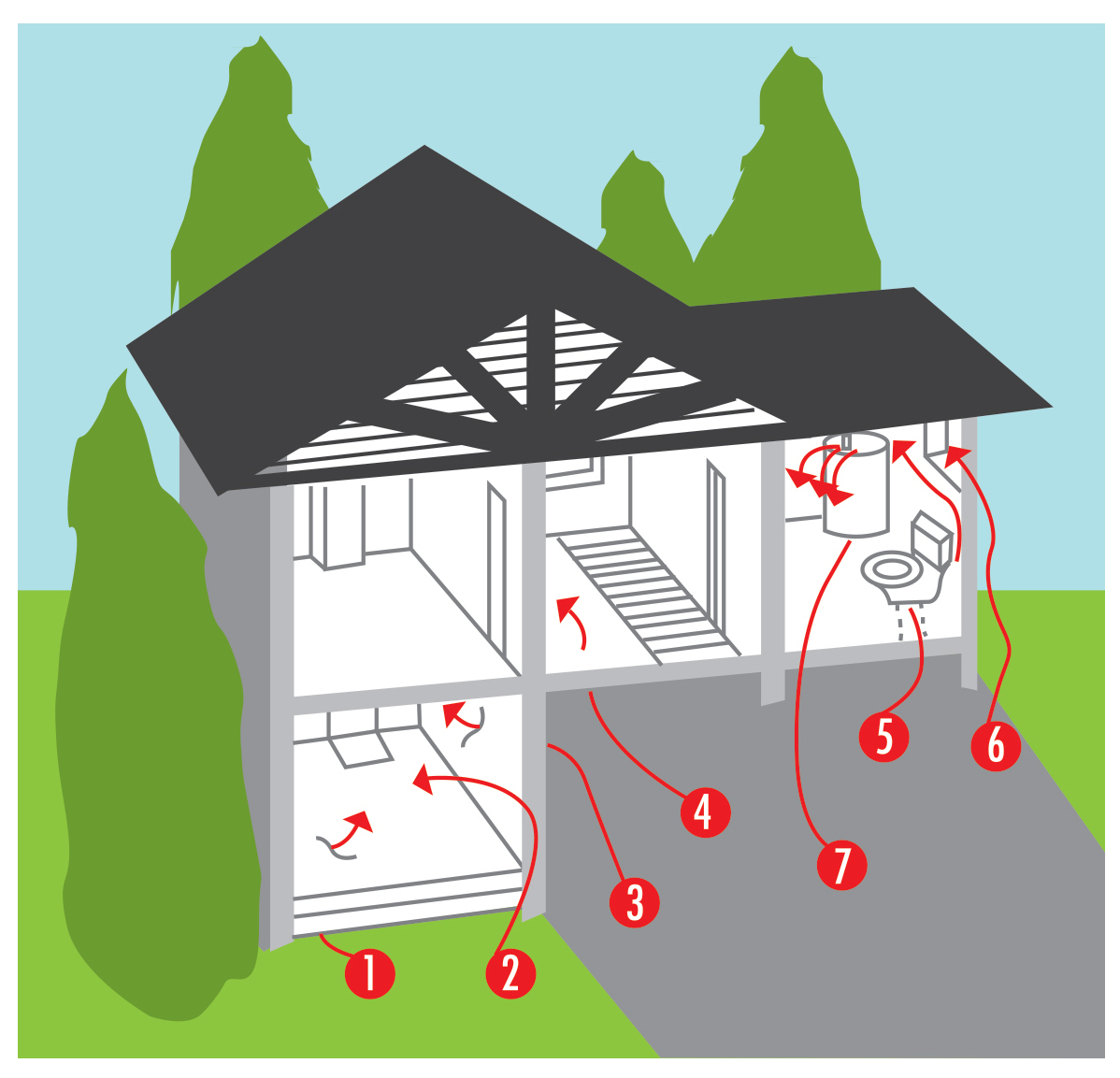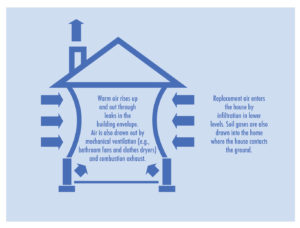All homes have some type of radon entry pathway. There are four main factors that permit radon to seep into homes:
- Uranium is present in the soil nearly everywhere in the United States.
- The soil is permeable enough to allow radon to migrate into a home through the slab, basement or crawlspace.
- There are pathways for radon to enter the basement, such as small holes, cracks, plumbing penetrations, and sump pumps.
- A difference in air pressure between the basement or crawlspace and the surrounding soil draws radon into the home.
Radon enters through:
- cracks in otherwise solid floors;
- gaps in suspended floors;
- cracks in walls;
- cavities inside walls;
- gaps around service pipes;
- construction joints; and
- the water supply.

Radon Entry into a Home
How Does Air Pressure Affect Radon Entry?
The air pressure in a house is generally lower than in the surrounding air and soil, particularly at the basement and foundation levels. This difference in pressure causes a house to act like a vacuum, drawing in air containing radon (as well as other soil gases) through cracks in the foundation and other openings. Some of the replacement air comes from the underlying soil and can also contain radon.
One reason this pressure difference occurs is that exhaust fans remove air from inside the house. When this air is exhausted, outside air enters the house to replace it. Another cause of a pressure difference is that warm air rises and will leak from openings in the upper portion of the house when temperatures are higher indoors than outdoors. This condition, known as stack effect, causes unconditioned replacement air to enter the lower portion of the house.
Does Foundation Type Affect Radon Entry?
Because radon can literally be sucked into a home, any home can potentially have a radon problem. All conventional house construction types have been found to have radon levels exceeding the action level of 4 pCI/L.
Basement
Radon can enter through floor-to-wall joints, control joints, and cracks in the slab.
Crawlspace
The vacuums that exist within a home are exerted in the crawlspaces, causing radon and other gases to enter the home from the area below. Even with crawlspace vents, a slight vacuum is still exerted in the crawlspace. Measurements of homes with crawlspaces have shown elevated radon levels.
Slab-on-Grade
Radon can enter a home regardless of whether it has a basement. Slabs built on grade can have just as many openings to allow radon to enter as do basements.
Manufactured Homes
Unless these structures are set up on piers without any skirting placed around them, interior vacuums can cause radon to enter these types of homes as well.
Can radon be kept out by sealing all of the cracks?
Sealing large cracks and openings is important when sealing a home, both in the lower portion of the home to reduce radon entry points, and in the upper portion of the home to reduce stack effect. However, field research has shown that attempting to seal all of the openings in a foundation is both impractical and ineffective as a stand-alone technique. Radon can enter through very small cracks and openings, and these can be too small to locate and effectively seal. Even if all cracks could be sealed during construction, which would be costly, building settlement may cause new cracks to occur. Therefore, sealing large cracks and openings is one of the key components of radon-resistant construction, but it’s not the only technique that should be employed.
Conclusion
In conclusion, all homes have a type of radon entry pathway, and the main types of residential foundations can permit radon entry. However, radon entry can be reduced by sealing large cracks and openings. Homeowners should be in contact with a radon professional to keep radon-related problems at bay.


